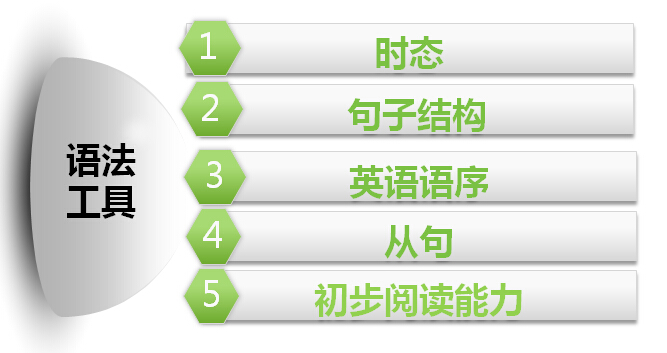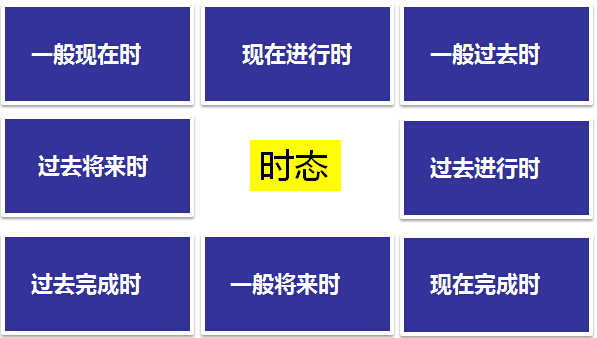|

语法工具-时态

一般现在时
|
定义 |
时间状语 |
结构 |
一般疑问句 |
否定句形式 |
|
1、一般现在时 |
经常、反复发生的动作或行为及现在的某种状况。 |
often, usually, always, sometimes, every
Day
(week,
month),
once a week,
on Mondays, etc. |
1.be动词
2.行为动词
主语+be+其他 |
1.把动词be放于句首。
2.用助动词do提问,如主语为第三人称单数,则用does,同时还原为动词原形。 |
1.am/is/are+not
2.此时态的谓语动词若为行为动词,则在其前加don’t;若主语为第三人称单数,则用doesn’t,同时还原行为动词。 |
表示现在经常反复发生的动作、存在的状态或习惯性的动作的时态。
常与一般现在时连用的词:
1、every系列
morning
afternoon
evening
day
week
month
year
2、频率副词

一次 once
两次 twice
三次 three times
一周两次 twice a week
每周四次 four times a week
每周六 on Saturdays
每周日 on Sundays
1.表示现在的状态:
e.g. He’s twelve.
She’s at work.
2.表经常或习惯性的动作:
e.g. I get up at 6:30 every day.
He reads English every morning.
常用的状语:often , sometimes , usually , every day 等。
3.表主语具备的性格和能力等:
e.g:
She likes noodles.
They speak French.
4.表示不受时间限制的普遍真理和自然规律:
e.g:
Two and four is six.
The moon goes around the earth.
一般现在时的构成
一、系动词be的一般现在时
二、情态动词的一般现在时
三、实义(行为)动词的一般现在时
一、系动词be的一般现在时
1、构成:
主语 + be + 其他
The girl is my friend.
2、be 包 括 哪 些 ?
is am are
3、 什么时候用is? 取决于主语是单数
什么时候用am? 还是复数
什么时候用are?
一、系动词be的一般现在时
1、构成:
主语 + be + 其他
The girl is my friend.
2、be 包 括 哪 些 ?
is am are
3、 什么时候用is?
什么时候用am?
什么时候用are?
Exercise
1、Kitty is an English girl.
2、We are students.
3、I am from China
4、She is tall.
5、Lucy and Lily are good friends.
6、Those chairs are broken.
7、The bag is mine.
一般现在时的构成
一、系动词be的一般现在时
二、情态动词的一般现在时
三、实义(行为)动词的一般现在时
情态动词的一般现在时
构成
主语 + 情态动词 + 动词原形+其他
She can speak English.
注意:情态动词后的动词一定要用原形
Eg: They should(应该) be right.
试比较:They are right.
She speaks English.
主语 + 情态动词 + not + 动词原形 + 其他
can not = can’t
could not = couldn’t
must not = mustn’t
would not = wouldn’t
will not = won’t
should not = shouldn’t
may not =may not
She (can not) speak English.
You (must not) open the door.
They (should not) be right.
I (will not) go to Japan.
一般现在时的构成
一、系动词be的一般现在时
二、情态动词的一般现在时
三、实义(行为)动词的一般现在时
行为动词的一般现在时
构成
主语 + 行为动词 + 其他
These boys like playing football.
The girl reads English every morning.
注意:当主语为第三人称单数时,
行为动词要加s或者es
什么时候加s,什么时候加es呢?
1、大多数动词在词尾直接加s,
read → reads look→ looks play→ plays
2、以辅音字母加y结尾的动词,要先将y变为i,再加es
如:fly →flies carry →carries study →studies
26个字母中 除A E I O U五个元音字母外,其余21个都是辅音字母
3、以“s, x, ch, sh”结尾的,在词尾加“es”,发音为[iz]
如: teach-teaches [iz]; watch-watches [iz] box---boxes
4、以“o”结尾的动词,加“es”,读[z]
如:go-goes [z] do-does [z]
Complete the sentences. Use the simple present tense of the verbs in brackets
1.My father listens (listen) to the radio every day.
2.Mike studies (study) in a middle school.
3.She takes (take) Eddie for a walk after supper.
4.He washes (wash) clothes with his hands.
5.Simon passes (pass) the ball to Daniel.
6.Miss Li teaches (teach) Chinese.
7.Look at the animal, it has four legs.
否定句的构成
主语 + 助动词(do/does)+not +行为动词原形 + 其他
These boys don’t(do not) like playing football.
These boys like playing football.
The girl doesn’t (does not)read English every morning.
The girl reads English every morning.
什么时候用助动词do,什么时候用助动词does呢?
取决于主语
当主语为复数时,用助动词do构成否定
当主语为单数时,用助动词does构成否定
注意:don’t 和 doesn’t 之后动词一定要用原形
Model 1: I like fish. (meat)
I don’t like meat.
Model 2. He likes reading. (writing)
He doesn’t like writing.
His brother plays football after school.
(play basketball)
His brother doesn’t play basketball.
It doesn’t look like a hat.
She doesn’t have a cat at home.
1. Jordan plays (play) basketball.
He doesn’t play (not play) football.
2. I go (go) swimming on Sunday.
But I don’t go (not go) shopping.
3. My cousins enjoy (enjoy) computer games.
But they don’t enjoy (not enjoy) ball games.
4. You like (like) fish.
But he doesn’t like ( not like) fish. |